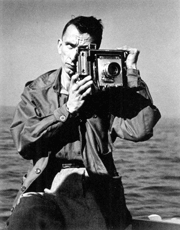|
||||||||||||||
Marion Warren, Picture Maker
June 18, 1920 – September 8, 2006A photo memorial with pictures from all
|
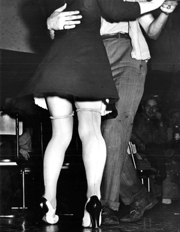 |
| 1948 |
In seven decades of making pictures, Warren captured your life. He snuck up on fleeing time, seized it with a camera and printed it on film. Looking at the pictures he made, you understood why native people fear the camera as a thief of souls. Warren had your soul all right. Even if he never made your picture, your soul was there, printed in those big black-and-white photographs he made, looking back at you from the eyes of three boys, frozen in friendship and fun in 1940; reflected in the anticipation of five surf-bathers, stepping into the breaking waves on a summer day in 1958.
He came into photography early in its history.
“When I was getting started in photography,” he recalled for a Bay Weekly interview in 1998, “a salesman from the Kodak Company said, you’re late getting into photography: Everything’s been photographed. I always laugh at that. Nothing’s been photographed yet.”
In the 1930s, the art was still magical. Photos could capture life; everybody believed it, and having the power made you a magician.
This is how I looked, you said, if you happened to be the subject. This is how we lived, you said, if Warren’s picture reflected a part of the world you knew or a thing you’d done — even dreamed of doing. This is real, you said, even if you’d never come close to the place or moment Warren captured — until you saw his image.
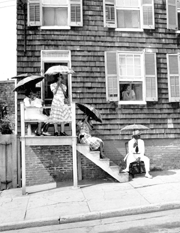 |
|
1948
|
His pictures made life big and real, the way you dream your life will be before dreams waft away in
daylight. His pictures reached out to us twined with our lives. We read our own stories into them and felt legendary.
Warren never made my picture. But I felt as if he’d seen my life before I had and hidden images of it away, like prizes on a treasure hunt, for me to discover in wonder.
Every one of us who’s ever seen a Warren photo feels a connection: We’ve been seen, captured, understood. There are uncountable thousands of us, for Warren made far more than 100,000 pictures, many of them so widely reprinted that they’ve become icons. His images have grown to be accepted symbols of the real thing. We see our place, our lives, our history through his eyes.
Warren’s own soul is twined in his pictures, too, which is why all his pictures throb with life. You can look at West Street, Annapolis,
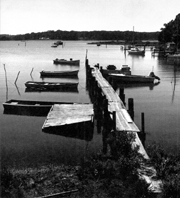 |
tumbled with cars, signs and wires in March of 1965; Baltimore, balanced on the cusp of change in the 1970s; or the deserted shamble of a Shady Side pier in 1985. Not a person in sight, but life charges through the photos as if driven by a beating heart.
“This photograph is a good example of my belief that when you see a photograph, you should always stop and take it right then because it probably won’t be there when you return,” Warren wrote of the Shady Side pier, captured “in a one-time opportunity of dramatic lighting” on August 12, 19 years ago.
Every moment of life is a one-time opportunity, and Warren was there, knowing and watching, when the rest of us might have been snoozing.
“You’ve lived your whole life in a state of heightened awareness of what it means to be alive?” Bay Weekly asked Warren in our 1998 interview
“Yes, you’re exactly right,” he said.
Life with a Camera
Photography worked for Marion in more ways than one. He used it not only to document the life around him but also to create his own life.
The skinny orphan farm boy bought his first camera, an Argus, in 1938. Barely out of high school, he got himself hired by the Associated Press in St. Louis, shooting everything from “airplane accidents to the straight stuff.”
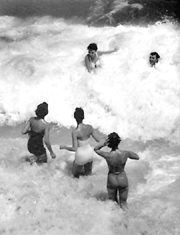 |
|
1958
|
Warren came of age in World War II, and enlisted in the Navy. Detailed to Washington, D.C., he shot for the Secretary of the Navy. One of the lingering images of those years is the last family portrait of Franklin Delano Roosevelt, made six weeks before the four-term president’s death.
After the war, Warren settled in as a photographer of peace and prosperity, capturing the range of life from weddings to soaring industrial achievement. He’s been a studio, commercial, industrial and architectural photographer. (His story of how he photographed the single span of the Bay Bridge is almost as good as his famous picture.) He’s also worked many years as a freelancer photographer, making pictures for world-class magazines like Fortune and Life, Sports Illustrated and National Geographic. In Chesapeake Country, we know him as a conservationist, as well, who used his art to show us what we’ve had and how our ways are changing and endangering our heritage.
With his young wife and partner Mary and a growing family — Paul, Nancy and Mame — to support, Warren established himself by ubiquity and generosity. He joined community groups — Chamber of Commerce, Severn River Association — came to their meetings, took their pictures. He allowed his photos to be widely reprinted, often for the exposure. That’s how we’ve come to know him so well.
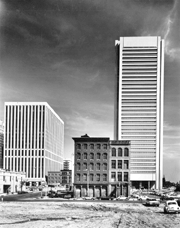 |
| 1969 |
It’s also how he — and through him, all of us — came to know Maryland. As a young man making his reputation, he bartered with the Maryland office of information, trading photographs for travel. His photographic records of family excursions around the state have come to be all of our family albums of Maryland in the last half of the 20th century.
The Warren family travels have been historical as well as geographic as he and first his wife, Mary, and then his archivist-historian-writer daughter, Mame, searched dusty old records and family albums for images he preserved first as modern negatives, then as historic books. First, with Mary, came Annapolis Adventure: Then and Now and The Train’s Done Been and Gone. Then, on the Naval Academy, Everybody Works But John Paul Jones.
Next, father and daughter collaborated on Maryland Time Exposures, 1840–1940; and Baltimore: When She Was What She Used to Be. On her own, Mame published Then Again Annapolis.
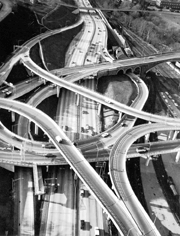 |
| 1965 |
The Eye of the Beholder documents a half-century of Warren’s career. Bringing Back the Bay: The Chesapeake in the Photographs of Marion E. Warren and the Voices of Its People, with Mame Warren, tells the story of Chesapeake Bay’s culture, troubles and struggle toward recovery.
He’s been featured in a documentary on Maryland Public Television, a cover story in The Washington Post Magazine and a retrospective exhibit at St. John’s College Mitchell Gallery.
In 1997, he donated more than 100,000 negatives and prints to the Maryland State Archives, where the catalogued Marion E. Warren Collection is now a resource for us all.
Warren was named an Admiral of the Chesapeake, Maryland’s highest environmental honor, in 1998 by then Gov. Parris Glendening.
“His life’s work has been capturing the spirit of the people and places of Chesapeake Bay,” Glendening
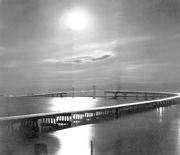 |
said. “He and his artistry are truly an enduring legacy and invaluable gift to us all.”
He was recognized by Gov. Robert Ehrlich for his last book, Water Views, with Steve Carr and Eric Smith, in 2003. In 2004, he was awarded the Scenic Rivers Land Trust Profile in Stewardship award, for “his extraordinary work in bringing the beauty and changing landscape of the Chesapeake Bay to so many through his masterful photography.”
Since the late 1990s, Warren endured ill health and, in 2003, the death of Mary, his wife of 60 years. But he rebounded time after time, continuing to work and to extend his art and renown.
Since 1998, Katherine Burke has collaborated with Warren to promote his work, first online (www.mewarren.com), then showing and selling his original silver gelatin prints in the Annapolis Publishing
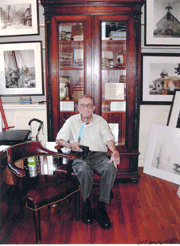 |
Collection at 14 State Circle (open Tues. thru Sun.: 410-280-1414). Throughout 2005 and into 2006, he enjoyed meeting his fans there.
In later years, over two moves, many old negatives turned up and were printed for the first time.
With business partner Joanie Surette, Warren also collaborated with Richard Olsenius, using a fine-art archival process to finally print the color photographs he’d taken over 60 years. That work is now on exhibit through October 20 at Maryland Hall for the Creative Arts’ Balcony Gallery (open daily except Mon. Oct 2: 410-263-5544).
Warren’s vital heart stopped beating six days before his Maryland Hall color show opened.



